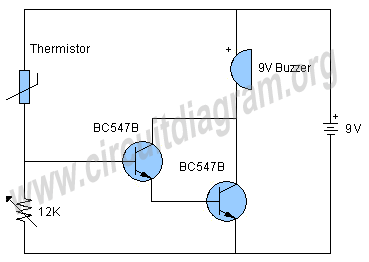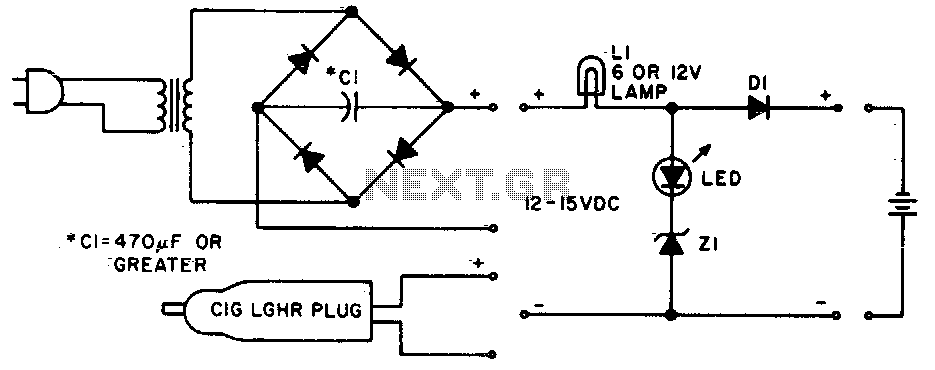
Low Voltage Alarm

This low voltage circuit can be used to monitor batteries and other volatile sources of current for problems. The circuit sounds an alarm and lights an LED, but can be interfaced to any number of other circuits for many different uses.
The low voltage monitoring circuit is designed to provide real-time feedback on the status of batteries and other current sources, ensuring that any irregularities in voltage levels are detected promptly. The circuit typically consists of a voltage divider, a comparator, an LED indicator, and a sound alarm, which can be integrated into a broader system.
The voltage divider is formed by two resistors connected in series across the battery or current source. This configuration reduces the voltage to a manageable level for the comparator, which is the heart of the monitoring system. The comparator is set to a reference voltage that corresponds to the acceptable range for the battery voltage. When the voltage from the battery falls below this threshold, the comparator output changes state.
The output of the comparator is connected to a transistor, which acts as a switch. When the comparator detects a low voltage condition, it turns on the transistor, allowing current to flow through the LED and the alarm circuit. The LED illuminates to provide a visual indication of the problem, while the alarm sounds to alert users to the issue.
Additionally, the circuit can be designed to interface with other systems. For instance, it can send a signal to a microcontroller or a more complex alarm system for further processing or logging of the event. This flexibility allows the circuit to be customized for various applications, including battery management systems, power supply monitoring, and other safety-critical environments.
Overall, this low voltage monitoring circuit is a versatile and essential tool for ensuring the reliability and safety of battery-operated devices and other electronic systems.This low voltage circuit can be used to monitor batteries and other volatile sources of current for problems. The circuit sounds an alarm and lights an LED, but can be interfaced to any number of other circuits for many different uses.
🔗 External reference
The low voltage monitoring circuit is designed to provide real-time feedback on the status of batteries and other current sources, ensuring that any irregularities in voltage levels are detected promptly. The circuit typically consists of a voltage divider, a comparator, an LED indicator, and a sound alarm, which can be integrated into a broader system.
The voltage divider is formed by two resistors connected in series across the battery or current source. This configuration reduces the voltage to a manageable level for the comparator, which is the heart of the monitoring system. The comparator is set to a reference voltage that corresponds to the acceptable range for the battery voltage. When the voltage from the battery falls below this threshold, the comparator output changes state.
The output of the comparator is connected to a transistor, which acts as a switch. When the comparator detects a low voltage condition, it turns on the transistor, allowing current to flow through the LED and the alarm circuit. The LED illuminates to provide a visual indication of the problem, while the alarm sounds to alert users to the issue.
Additionally, the circuit can be designed to interface with other systems. For instance, it can send a signal to a microcontroller or a more complex alarm system for further processing or logging of the event. This flexibility allows the circuit to be customized for various applications, including battery management systems, power supply monitoring, and other safety-critical environments.
Overall, this low voltage monitoring circuit is a versatile and essential tool for ensuring the reliability and safety of battery-operated devices and other electronic systems.This low voltage circuit can be used to monitor batteries and other volatile sources of current for problems. The circuit sounds an alarm and lights an LED, but can be interfaced to any number of other circuits for many different uses.
🔗 External reference
Warning: include(partials/cookie-banner.php): Failed to open stream: Permission denied in /var/www/html/nextgr/view-circuit.php on line 713
Warning: include(): Failed opening 'partials/cookie-banner.php' for inclusion (include_path='.:/usr/share/php') in /var/www/html/nextgr/view-circuit.php on line 713





